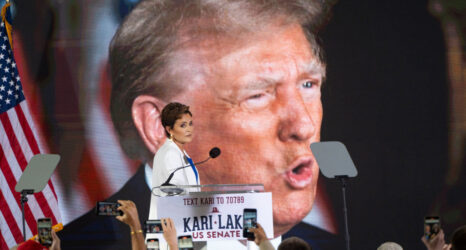At the Met Gala, the extreme wealth on display called on the “gilded” hubris of an historical era that seemed more “golden” than it was—while the leaked Supreme Court opinion previewed a dystopian, despairing future.
There’s a succinct meme featuring the late soul-singing legend Aretha Franklin throwing her most elegant diva “shade” at a pop star when she responded to a question about that artist’s talent by simply stating: “Great gowns, beautiful gowns.”
That type of signifying has become a convenient shorthand for refraining from any negative criticism of someone or something by offering a backhanded compliment. In recent pop culture, I’ve been relying on the Franklin quote that so aptly describes my admiration for the sartorial choices of certain television shows (Netflix’s Bridgerton and HBO’s The Gilded Age), while shielding my disdain for their storytelling choices, which often rely on revisionist multiracial utopias that never existed or softened depictions of racism and sexism to make room for the cosplay “dress-up” our contemporary fantasies like to create about the mythical past. Never mind the bone-crushing corsets or the appropriative echoes of the “Hottentot Venus” in the Gilded-Age bustle. At least we have “great gowns, beautiful gowns”!
Knowing what we know of the “Gilded Age”—the era of the late 19th century, so named by American author Mark Twain because of the rapid industrial and economic growth of the U.S. that led to an increasing wealth gap reflected in the garish displays of the wealthy, more gilded than gold—perhaps it was only fitting that this year’s Met Gala, sponsored and hosted by Vogue’s iconic editor Anna Wintour to benefit the Costume Institute at the Metropolitan Museum of Art, would feature a “Gilded Age” theme for the “great gowns, beautiful gowns,” worn by invited A-list celebrities in the midst of an ongoing pandemic, racial divides, rising inflation costs, and the widening gap between the top 1 percent and everyone else.
However, it was during this event on May 2, 2022, that a leaked draft of the majority opinion from the U.S. Supreme Court circulated on social media and immediately sent shockwaves as the public learned that our highest court intends to overturn Roe v. Wade (1973), which guarantees women and all people with the capacity to become pregnant the right to a legal and safe abortion. Suddenly, the extreme wealth on display at the Met Gala seemed to represent all the “gilded” hubris of an historical era that seemed more “golden” than it really was, as we are now thrust back not just into our present-day reality but to a truly dystopian and despairing future that we must confront and resist at all costs.
What few of us realize, however, is that the “Gilded Age” theme of the Met Gala is quite apropos, given how this is the same era that ushered in our first anti-abortion laws. This is one of the issues that I take with our misrepresentations of the past, in pop culture and elsewhere. If we’re not looking back fondly on a pretend past with romanticized feelings of nostalgia, we instead assume that our historical timeline is an unending linear progression, when the truth is our timelines are more like spirals as we “ebb and flow” in our experiences of advancements and setbacks—one step forward, two steps backward, and so forth.
The “Gilded Age” theme of the Met Gala is quite apropos, given how this is the same era that ushered in our first anti-abortion laws.
Just as we cannot assume a “linear progression” of history—which supposes that all we have to do is wait for our white supremacists and misogynists to eventually die—so too must we also recognize that none of our laws, customs and cultural narratives are set in stone. Prior to the Gilded Age, women across races and socioeconomic backgrounds practiced various forms of contraception and shared within their “whisper networks” and at kitchen tables various remedies and abortifacients (some worked, some didn’t). Midwives—Indigenous, Black and white alike—did the important work of prenatal, postpartum and maternal care until the development of gynecology and obstetrics.
These biomedical spheres were literally built on the experimented-upon bodies of enslaved women like Anarcha, Betsy, and Lucy through the surgeries of J. Marion Sims. Moreover, physicians like Horatio Storer discredited midwifery, barred women from the profession, and pushed for the criminalization of abortion—all with the intent to control women’s bodies.
How eerie that history would repeat itself, not just in today’s attacks on reproductive freedoms but also with the attacks on Black advancements and immigration, as the Gilded Age also included Post-Reconstruction racial violence and legal setbacks against African American rights, as well as immigration bans, such as the 1875 Page Act, which banned Chinese women from the United States (under the guise of prohibiting “prostitution”)—a precursor to the 1882 Chinese Exclusion Act.
Yes, the fashions of the Gilded Age are fabulous, and our most progressive and radical change agents from the era—from the great liberator Harriet Tubman to militant journalist Ida B. Wells to Black club women like Anna Julia Cooper, Fannie Barrier Williams and Mary Church Terrell—all loved to dress up with the best of the respectable, well-to-do classes of women. But we cannot reduce women to outward appearances when “our bodies, our choices” require our urgent attention to our holistic health and well-being, both personally and collectively.
We cannot reduce women to outward appearances when “our bodies, our choices” require our urgent attention to our holistic health and well-being, both personally and collectively.
The misguided fixation on “beautiful gowns” was perhaps best represented at the gala by Kim Kardashian’s controversial and dangerous weight loss of 16 pounds in three weeks, just to fit into the iconic gown custom-made for and worn by Marilyn Monroe when she had famously serenaded President John F. Kennedy. Despite her weight loss, Kardashian still had to cover the back of her gown since it did not fit over her alleged surgically-enhanced backside.
How ironic that, after years of appropriating the bodies and sartorial choices of Black women, this same “big booty” aesthetic could not fit the retrospective “blonde bombshell” ideal from a bygone era. Interestingly, Kardashian’s fashion faux pas highlights the changing cultural and aesthetic landscape that represents today’s multiracial America, and given Monroe’s tragic life and premature death in comparison to Kardashian’s reproductive freedoms in having children within an interracial marriage—both biologically and through surrogacy—we must recognize the progress women have made in the past 50 years (some more privileged than others) and what now hangs in the balance.
Two other instances at the gala deserve our attention. The first is the digital rendering of the Vogue cover of pregnant pop star and fashion icon and entrepreneur Rihanna in “marble,” displayed alongside classical sculptures from antiquity. It is a “gilded” approximation of history in the making and a projected optimism for the future. Let us hope this celebration of a young Black billionaire restyling maternity fashion and choosing to become a mother on her own terms does not get frozen in time as a tribute to only those with resources who can exercise their reproductive freedoms while the vast majority of Black pregnant women and people giving birth are trapped by Draconian laws that put their and their infants’ health in jeopardy.
The second and more powerful image from the gala has to be that of filmmaker Radha Blank of Netflix’s The 40-Year Version fame who donned a Jennifer McFarlene gown while carrying a faux machete in the style of “an Obeah woman who by day used her hands to sew, cook, wash White folk clothes & tend to their chirren and by night used her hands to conjure spells for our survival using ancestral African spiritual practices not meant to survive the middle passage.”
That Blank would have to use her imagination to create the style of “unseen Black women who have sewn the fabric of this country” is the kind of Black feminist resistance we must now employ to recognize our past, confront our present realities, and push toward a future that was never set in stone—indeed, one we can digitally alter Rihanna-in-marble style.
Our histories and futures must be shaped by our present-day actions as we continue to strive toward liberatory visions. Let our progress be real and not trapped by a “gilded” dream of a past that never was. We are more than just “great gowns, beautiful gowns.”
Sign and share Ms.’s relaunched “We Have Had Abortions” petition—whether you yourself have had an abortion, or simply stand in solidarity with those who have—to let the Supreme Court, Congress and the White House know: We will not give up the right to safe, legal, accessible abortion.
Up next:





